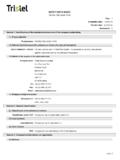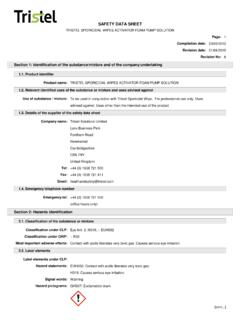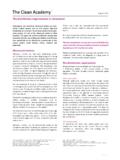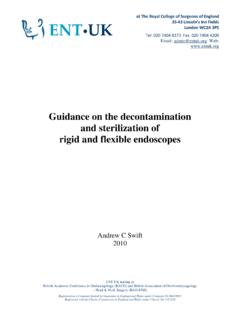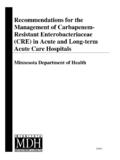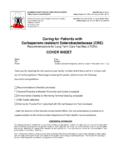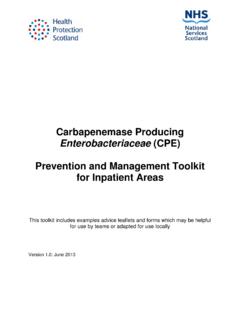Transcription of The importance of cleaning before disinfecting - Tristel
1 Page 1 of 3 In environments where diseases are constantly being treated, the risk of spreading Healthcare-Associated Infections (HCAIs) is extremely high. In order to prevent microorganisms from spreading, hospitals and other healthcare institutions have to maintain a high-quality decontamination programme. cleaning and disinfection both belong to this programme and are strongly related to one another, yet they are sometimes understood to be the same thing. This paper explains the differences between cleaning and disinfecting along with their importance as part of the decontamination programme. cleaning versus disinfection Whilst cleaning is an important process in most industries, it is of critical importance in healthcare. In hospitals and other institutions such as long-term care, ambulatory care and home care, microorganisms can spread rapidly on environmental surfaces and medical Environmental surfaces in healthcare settings are defined as surfaces that surround a patient and are frequently touched by hands.
2 The floor is the first environmental surface that comes to mind. Other surfaces such as patient furniture ( bedside tables, bed rails) also belong to this Medical devices are defined as items intended to be used for a medical diagnosis or therapeutic procedure. Endoscopes, transoesophageal echocardiography probes (TOEs or TEEs), ultrasound transducers and endo-cavity probes are all examples of medical In the United States, the Centers for Disease Control and Prevention (CDC) state that infection prevention, such as environmental cleaning , should be made a priority in all healthcare settings. Environmental cleaning is defined as the routine cleaning and disinfection procedure of all environmental surfaces. In this particular context, the word cleaning is used not only to describe the action of cleaning , but also the action of disinfecting . Here lies a possible confusion between cleaning and disinfection.
3 The two terms are described as follows: cleaning refers to the removal of visible soil and organic matter such as blood, mucous and tissue. This first stage is usually achieved by a detergent combined with water. A 1 The American Journal of Infection Control cleaning and disinfecting environmental surfaces in health care: Towards an integrated framework for infection and occupational illness prevention Volume 43, Issue 5, Pages 424-434 2 Centers for Disease Control and Prevention Guideline for Disinfection and Sterilization in Healthcare Facilities, 2008 3 European Commission Medical Devices: Guidance document MEDDEV April 1994 detergent is a chemical agent containing one or more surfactants. These surfactants reduce the surface tension, making it easier for the liquid to access soil and organic matter and remove them. Two different kinds of detergents can be found on the market: enzymatic and non-enzymatic.
4 Enzymes are a class of proteins that accelerate and increase the effect of a chemical reaction. When added to a detergent, the enzymes break down the molecules into smaller ones, maximising the removal of residues. Disinfection refers to the removal of microorganisms such as bacteria, yeasts, fungi, viruses, mycobacteria and spores. The number of microorganisms removed defines the level of the disinfectant: low-level, intermediate-level or high-level. The first two are typically described as chemical solutions that kill microorganisms with the exception of bacterial spores (for intermediate-level disinfectants) and mycobacteria and bacterial spores (for low-level disinfectants). High-level disinfectants are more powerful and differ from this definition as being effective against bacterial cleaning and disinfection should be strongly combined as part of the decontamination programme. Detergents contain cleaning properties that remove soil and organic matter, and disinfectants contain the active ingredients that remove the microorganisms which lead to HCAIs.
5 Many guidelines highlight cleaning as the most important part of the decontamination programme. Without cleaning , soil and organic matter can affect the active ingredients of the disinfectant and reduce its efficacy. Organic matter can create a barrier and prevent the disinfectant from removing the microorganisms which lead to infections. The importance of cleaning is also strongly emphasised when it comes to disinfectants that do not present good results when tested under dirty When choosing a detergent, healthcare professionals need to verify its efficacy and its compatibility with the disinfectant that will follow. Not using an effective detergent prior to disinfection can produce ineffective results and create a dangerous environment within a healthcare facility. 4 Centers for Disease Control and Prevention Guide to infection prevention for outpatient settings 2014 5 Inside Hospitals cleaning endoscopes Considering the risks and benefits of enzymatic and non-enzymatic detergents June 2012 6 Infection Control Today General Guidelines for Use of Chemical Disinfectants January 1, 2001 March 2016 The importance of cleaning before disinfecting Page 2 of 3 The decontamination process Decontamination is a general term used to describe the removal of microorganisms through a combination of processes which can include cleaning , disinfecting and Several types of decontamination processes can be distinguished.
6 They differ based on the classification of the medical device. This classification, known as the Spaulding Classification, depends on the risk of becoming infected with a device and includes: Non-critical items Items that only touch the intact skin of a patient. These items can include environmental surfaces and medical devices, such as blood pressure cuffs and stethoscopes. As the skin acts as a barrier against microorganisms, cleaning followed by a low or intermediate-level disinfectant is usually enough. However, high-level disinfection is often recommended as patients can suffer from injuries or wounds, allowing the organisms to enter the body and cause infections. High-level disinfection is also recommended when it comes to outbreak prevention. Semi-critical items Items that come into contact with non-intact skin or mucous membranes, and do not typically penetrate sterile tissues. These items include instruments such as endoscopes and manometry catheters.
7 cleaning and high-level disinfection is required as a minimum. If contact has been made with sterile tissues, sterilisation is required. Critical items These items include instruments such as biopsy forceps and injection needles. cleaning and sterilising are required for these instruments in order to achieve a complete removal of all microorganisms, including bacterial Reprocessing semi-critical items Each instrument usually has its own reprocessing guidelines which need to be followed by the healthcare professional. The decontamination process of flexible endoscopes has for instance been divided by the English Department of Health (DH) into several stages. These stages include: cleaning Water and detergent that are used to remove the visible soil and organic loads from the device. Rinsing Although optional, this stage might be required if the cleaning 7 Nursing Times The principles of decontamination 8 MedEducation Spaulding Classification agent is not compatible with the chemical disinfectant that follows.
8 Chemical disinfection A high-level disinfectant effective against mycobacteria, viruses, fungi, bacteria and a small number of bacterial spores. Final rinse To remove any residue left by the disinfectant. Some high-level disinfectants are known to be toxic and can cause irritations on users and Although rinsing is not always necessary depending on the detergent and disinfectant used, the above stages can be applied to most semi-critical medical devices. Semi-critical medical devices are probably the main concern when it comes to HCAIs. Non-critical items do not tend to enter into contact with inside parts of the body and critical items tend to be sterilised in an autoclave. In 2011, a survey conducted by the Health Protection Agency (HPA) estimated the number of HCAIs within a few healthcare facilities. 52,443 eligible patients were recorded of which 3,360 ( ) were diagnosed with an HCAI.
9 The most common types of HCAIs were respiratory tract, urinary tract and surgical site infections. Although a decrease has been noted since 2006 ( of HCAIs were recorded at the time), more effort needs to be made to assure the implementation of a proper decontamination programme to keep the number of infections If it were possible, the sterilisation of semi-critical devices, such as endoscopes, would be done automatically, for instance in an autoclave. This would remove all microorganisms, including bacterial spores. Sterilisation is however expensive and not compatible with all instruments. High-level disinfectants usually suffice but they need to be selected and used properly. A wide variety of high-level disinfectants is available on the market. Healthcare professionals need to make sure the selected disinfectant is strong enough to kill microorganisms, including a small number of bacterial spores, while allowing for an easy implementation of the decontamination programme.
10 An efficient detergent needs to be applied prior to high-level disinfection. In the case of lumened endoscopes, insufficient cleaning could result in soil and organic matter blocking the endoscope s channel(s) impeding the high-level disinfectant from removing any microorganisms. 9 Department of Health CFPP 01-06 Decontamination of flexible endoscopes: Operational management 2013 Page 14 10 Health Protection Agency English National Point Prevalence Survey on Healthcare-associated Infections and Antimicrobial Uses, 2011 Page 3 of 3 Tristel Trio Wipes System The Tristel Trio Wipes System is a three-part decontamination system which includes: A cleaning wipe impregnated with an enzymatic detergent used to remove soil and organic matter from the device. A sporicidal wipe impregnated with a citric acid solution activated with a foam composed of sodium chlorite. When activated with the foam, the wipe produces a sporicidal, mycobactericidal, virucidal, fungicidal and bactericidal chlorine dioxide (ClO2) chemistry, effective in 30 seconds.
